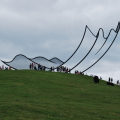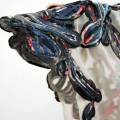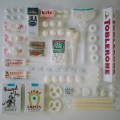“With a cast of colorful characters who would do justice to any repertory stage, Iwajla Klinke infuses portrait photography with the magic and elegance of its early years, when one of its primary goals was to document and celebrate ritual moments in an individual’s life. The snapshot aesthetic of the last century and the ubiquity of digital images today has diminished the ceremonial aspect of picture-taking in favor of what William Eggleston once termed the “democratic camera.” In contrast, ceremony is at the core of Klinke’s approach. Her camera records subjects whose very clothing points to individuality, even to eccentricity, and where ritual is implicit. All of these studies are presented in a formal manner that sometimes recalls the conventions of the painted portrait. (The fact that Klinke’s works are printed with pigments on handmade paper further strengthens this link to classical traditions of picture-making.) With minimalist means, she achieves results of immense visual authority.
The elegant serenity of these compositions belies the haphazard circumstances that frequently surround their production in remote Carpathian villages or in Germany’s Black Forest. In 2013 alone Klinke was under way in Europe, Canada and Brazil. Her work can be seen in the tradition of the artist-traveler seeking and recording new impressions – much like those German artists who visited the New World in the 19th century in order to create visual records of vanishing tribes of Native Americans. For a single image in her own “Settimana Santa” series, Iwajla Klinke once traveled for 20 hours by bus to reach a small community in Sicily on Easter Sunday morning. By the time she located her young subject, less than a minute remained before mass began – time enough, though, to fasten a simple piece of cloth to the vestry door and photograph a young boy dressed as an angel. Such three-quarter studies, with a neutral background of black or brown, use natural light to create sepia-like effects strikingly reminiscent of a Vermeer painting. Yet what also seems to radiate here is an inner light, a kind of epiphany deeply rooted in rituals whose origins may well have been forgotten but whose spiritual energy persists. While Klinke has also produced theatrical studies of young people with bizarre accessories or in the contemporary “costumes” of fencers and American-style footballers, her signature pieces are studies of children dressed in elaborate traditional garb, often richly embroidered. For these studies the artist only works within the context of the religious ceremonies in which such attire is actually employed. There is no studied “posing” or extra dressing-up. This, she feels, would undermine the authenticity she seeks. Often a project may seem a race against time, since the use of a particular elaborate headdress in a single mountain village may be the last, fragile vestige of ancient ceremonies otherwise forgotten. Such work has an obvious documentary dimension, though Klinke sees this as secondary. “I don’t choose subjects for their anthropological value,” the artist insists. “I choose them for their beauty.” Nonetheless, the search for a motif may well involve considerable research and cross-cultural savvy. Serendipity, however, can also play a role – as in the recent discovery in Toronto of old-fashioned display mannequins wearing “communion suits” and lace ribbons bearing the name “Jesus” alongside a chalice. In attempting to decode Klinke’s multivalent oeuvre, it is interesting to note that she grew up in East Germany, where her mother’s family moved after World War II for ideological reasons, hoping to fulfill the dream of a better world. Her father, a Bulgarian opera singer, died when Iwajla was only six years old. “I had no religious upbringing,” Klinke explains, “ but I was fascinated by religious rituals, especially those involving children. These always have something to do with the conquering of death, and they are often accompanied by fertility symbols like the crown.” The fascination such rituals exerted was deepened by the discovery of The Golden Bough, Sir James Frazer’s comparative study of mythology and religion. In what would prove one of the most influential texts of the last century, the author approached religion as a cultural phenomenon, not from a theological perspective. Virtually all religions, he argued, derived from fertility cults revolving around the worship and periodic sacrifice of a sacred king. As such ceremonies evolved, the figure of a child – as martyr or as bridegroom – might replace the ancient heroes. It was in Berlin’s rough-and-tumble, multicultural Kreuzberg district that Klinke started photographing interesting figures she encountered in local parks and bars. She was particularly fascinated by subjects with all-over tattoos – with “magic texts,” as she called them, thus echoing a phrase from Frazer’s opus. In addition, she might ask young people to pose for her, clothed only in scraps of antique lace, necklaces of paper doilies, shuttlecocks or white mice, even with epaulets of dripping candles. More recently, she has created three studies of young men with body painting that imitates the blueand- white “Musselmalet” pattern introduced by Royal Copenhagen Porcelain in the 18th century but loosely derived from Meissen’s blue-and-white onion pattern. The slender figures of the three young men who “model” the cobalt-blue ornamentation have a touching fragility – like fine porcelain itself. (They are also a reminder that among tribalist cultures body painting frequently accompanied rites of passage, hunting and warfare.) The delicacy of the “Musselmalet” figures is even more dramatic if compared to the rugged cadets, in full Scottish dress regalia, who make up the series entitled “White Crowned Sparrow.” (As pupils at a Canadian boarding school, the cadets depicted here suggest that the outward trappings of ritual can also be effectively “transplanted.”) What such works have in common and share, indeed, with the portraits of Deaconesses in crisp white caps and bows is that all the protagonists wear a sort of uniform. That uniform, in turn, signifies shared values and goals. Far from suppressing individual identity, here the uniform actually enhances it. In the case of Klinke’s startling portraits of “Bee Kings,” the helmet worn is not only alive but also potentially lethal. Despite the impressive range of her more recent works, Klinke’s true trademark emerges in her stunning portraits of children dressed in ceremonial garments. Many of these date to the 19th century, symbolizing beliefs “that live on in the form of rituals,” according to the artist. Despite the speed a sitting may demand, one senses a very special relationship between the artist and her models. Whatever their age, the latter seem to surrender themselves gladly to the inquiring eye of her camera, while she in turn imbues her sitters with a compelling dignity.”






































